The Ultimate Guide to Wagyu Beef, the World’s Most Luxurious Steak
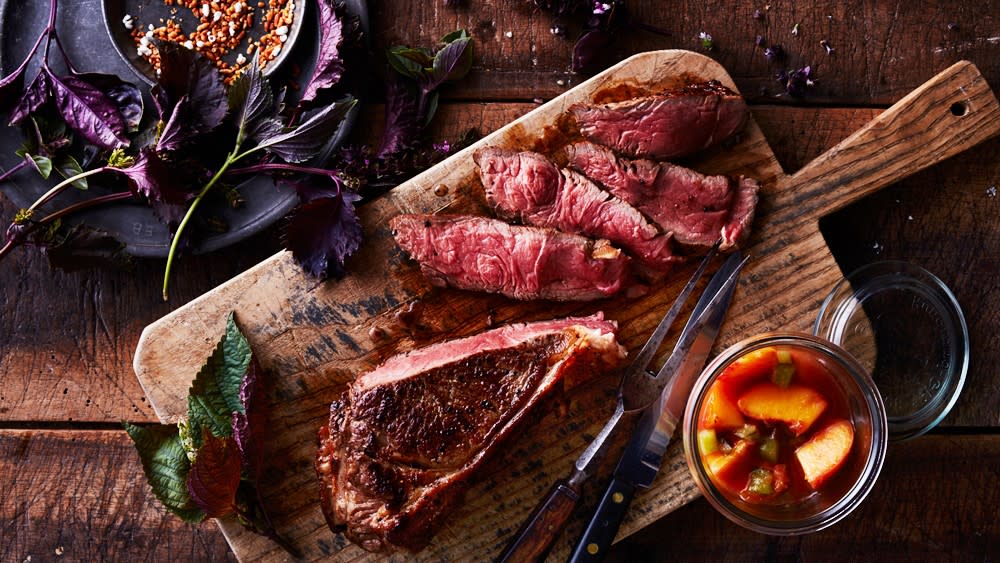
Wagyu beef—you know, the transcendently tender, fatty, umami-rich steak—has become as synonymous with luxury as caviar or black truffles. But no matter how many Michelin-starred menus this delicacy graces, all of the facts about Wagyu steak still tend to elude even the most seasoned diners.
“It’s an extremely fascinating but confusing world,” says Joe Heitzeberg, the co-founder and CEO of Crowd Cow. Heitzeberg, who admits it wasn’t until he’d spent ample time meeting with Japanese slaughterhouse owners and farmers (his minor in Japanese at the University of Washington helped) that he felt like he truly understood Wagyu.
More from Robb Report
15 Menswear Gems From Lululemon's 'We Made Too Much' Sale to Snag Before Black Friday
The 15 Best Beard Trimmers for Perfecting Your Stubble or Going Full James Harden
“There’s a lot of information out there that’s not accurate, mostly unintentionally, and perhaps some intentionally,” he says. Because of the prestige associated with Wagyu and the premium price it fetches (a pound can easily run in the triple-digits), some people throw around “Wagyu” and related terms as a marketing gimmick, even if what the purveyor is selling isn’t that luxury version. So what is Wagyu beef—and why does it taste and feel unlike any other steak you’ve ever had? We’ve gathered some of the foremost experts in restaurant industry to explain.
The editors of Robb Report scour the globe (and the Internet) for the best of the best and only endorse products we love—and think you’ll love, too. If you purchase a product or service through a link in this story, we may receive a small commission.
Related: Buy the Holy Grail Steak’s ultimate Wagyu experience to enjoy at home
What is Wagyu beef?
Simply put, Wagyu means Japanese cow, But the straightforward definition belies a subject riddled with misinformation.
For starters, it’s pronounced wah-gyoo, not wah-goo, a mispronunciation that’s common even among American Wagyu farms (and that admittedly tripped up even this intrepid reporter), says Heitzeberg.
And Wagyu isn’t an umbrella term for just any Japanese cow. The luxury version of Wagyu we all want on our plates refers to a specific breed of Japanese cattle with special genetic qualities. “There are four breeds native to Japan. Of those four breeds, one of the breeds is genetically unique,” Heitzeberg says. “It has a genetic predisposition to create this crazy marbling of fat on inside of muscle tissue. No other livestock does that.” Think of your average piece of steak. Chances are, it’ll have a fat cap on its outside. With Wagyu, the cow metabolizes the fat internally, so it’s integrated within the muscle.
“When I eat too much food it goes to my belly, but when they eat a lot of food and they get fat, that one breed gets it on the inside of the muscle,” Heitzeberg explains. This means any other breed, even raised by an award-winning Wagyu cattle farmer in the exact same conditions as Wagyu, would not produce Wagyu beef.
The result is a rich, luscious cut of beef that practically dissolves once it hits your tongue. “When you have very high-end Wagyu, you barely want to cook it. The middle you want to keep as raw as possible. But even if it were cooked medium or medium-well, it would still be juicy,” says Giuseppe Tentori, executive chef of GT Prime in Chicago. “Just slice it super thin so it melts in your mouth.
What’s the difference between Japanese and American Wagyu?
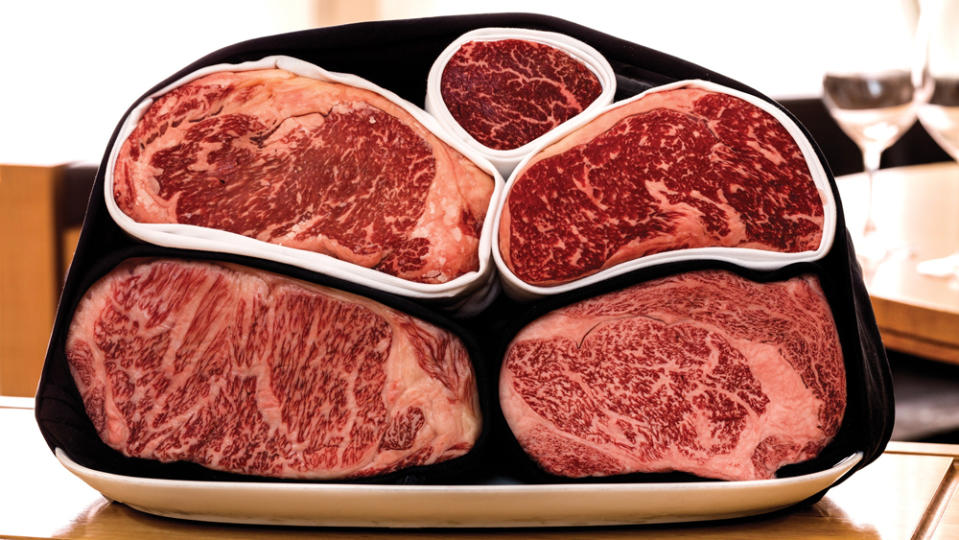
Photo: courtesy CUT by Wolfgang Puck
In addition to the looser rating system and divergent cattle-farming techniques, the biggest difference between American Wagyu and Japanese Wagyu is that Japanese Wagyu is purebred, where American Wagyu is crossbred. “[American Wagyu] is still going to be crazy marbled with intense flavor, but it’s most likely Wagyu bred with angus,” Henderson says.
“Almost all of that stuff is angus beef crossbred with Wagyu in an uncontrolled, unregulated, unspecified percentage of DNA,” Heitzeberg says. “I’ve eaten my bodyweight several times over in Japanese Wagyu and American Wagyu, and I haven’t tasted anything that’s angus mixed with Wagyu at any percentage that tastes like Japanese Wagyu does at 100 percent.”
Because of this, American Wagyu doesn’t have the sweet umami flavor that Japanese Wagyu does, and it never quite reaches that same melt-in-your-mouth level of marbling. Though Heitzeberg is quick to stipulate that this doesn’t mean that American Wagyu isn’t delicious.
“The American stuff is wonderful. You can eat more of it,” he says. “With the Japanese stuff, because it’s so fatty and rich, most people can’t eat more than a few bites of it before it’s so overwhelming. So if you’re in the mood for a steak dinner, and you want a giant steak, you can’t really do that with Japanese Wagyu.”
American Wagyu packs the familiar beefy flavor of an angus steak. “The Japanese stuff is almost like a light beer experience. You just don’t have as much of that beefy taste, and then you have that umami flavor that’s hard to describe. It’s almost like a sweetness,” Heitzeberg says.
If you have the opportunity, order one of each. “Try different types of Wagyu from different countries and compare one to the other,” Tentori says. “You’ll learn something new, and you will appreciate it for more than just being so expensive.”
Why is Wagyu so expensive?
As you’ll see from our selection of favorite purveyors below, Wagyu comes at a price. But why is Wagyu beef so expensive? Part of the reason is just the time it takes to raise cattle that produce A5 Wagyu. Whereas American angus cattle is usually slaughtered at around 18 months, Wagyu breeds in Japan will live for nearly three years before heading to the abattoir. Also, while they’re alive, Japanese cattle are fed a more costly diet than their American counterparts, helping contribute to the rich marbling A5 Wagyu is known for. But some of the price really just comes down to economics 101 and the laws of supply and demand. In Japan, there are 2.5 million heads of cattle while the United States has 91.9 million head, according to current USDA figures.
Best places to buy Wagyu online
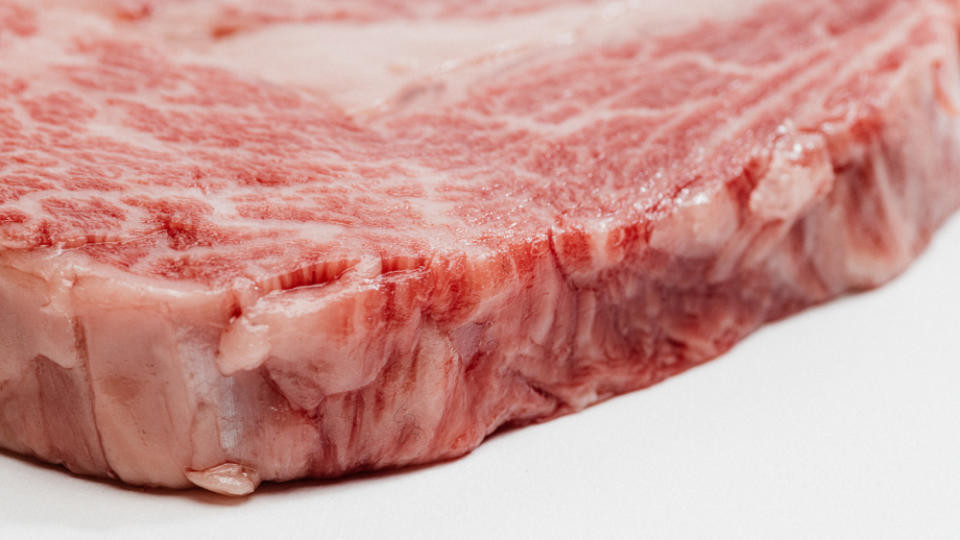
Teddy Wolff
You used to only be able to get the finest Wagyu in the world if you were at a high-end steakhouse or dining at a Michelin-starred restaurant. Or, of course, if you went to Japan. But over the years some outstanding importers have made inroads in Japan, working directly with ranchers to bring outstanding A5 to America. Additionally, US farmers have proliferated raising their own hybrid cattle. Here are five of our favorite purveyors.
Holy Grail Steak Co.
At Robb Report we scour the globe in search of the finest products and experiences, from watches to cars to restaurants. In Holy Grail Steak Co., we found a company similarly obsessed with sourcing the world’s best beef. When it comes to steak, that means Wagyu. Yet not all Wagyu is created equal: Robb Report and Holy Grail have partnered to curate a collection of beef that highlights the ultra-rich A5 from Japan and the beautifully marbled American cuts, so you can enjoy the ultimate Wagyu experience at home. The package includes A5 Wagyu strips from three distinct regions of Japan: Kobe, Miyazaki and Hokkaido. And then its packaged with some of the finest American Wagyu as well.
Crowd Cow
This company was originally founded on the idea of crowdsourcing beef, where a group of buyers on the internet could join together to procure a premium head of cattle and a great price, then call dibs on the part they wanted until it was gone. Crowd Cow has branched out a little more than that these days, become one of the top importers of A5 in America, selling a wide variety of cuts and different breeds from around Japan.
Meat N’ Bone
While a lot of purveyors, working with limited supplies, will be able to get you thin cuts of A5, Meat N’ Bone comes through with big, prime rib roast-sized cuts of the finest Japanese beef (all the way up to 11 lbs!) so you can be your own butcher, breaking down the meat exactly to your own specifications.
D’Artagnan
For years some of the best chefs in the game turned to D’Artagnan as a premier purveyor of gourmet ingredients from foie gras to wild game to humanely raised meats. The likes of Eric Ripert, Barbara Lynch, Daniel Boulud and more have been counted as customers and during the pandemic, the company started selling even more of its products to us mere kitchen mortals. Among the premium ingredients on offer is A5 Wagyu imported directly from Japan.
Mishima Reserve
From Beecher’s Handmade Cheese—the same outfit that brought us one of our favorite fromages made in the US—comes a company devoted to outstanding crossbred American Wagyu that boasts Kuroge Washu cattle bloodlines. Not quite as decadent as A5, Mishima’s steaks are less marbled and thus better for grilling than the ultra-fatty Japanese import. Mishima offers a wide variety of cuts as well as ground Wagyu for some decadent burgers.
Vermont Wagyu
While most of the Wagyu raised in the US is a crossbreed of Japanese and American angus cattle, Vermont Wagyu actually has been raising 100 percent purebred beef. That means the marbling on Vermont’s beef will be much richer than other American Wagyu you’ll find. The farm currently offers a quarterly subscription box so you can sample different cuts every few months.
History of Wagyu in Japan
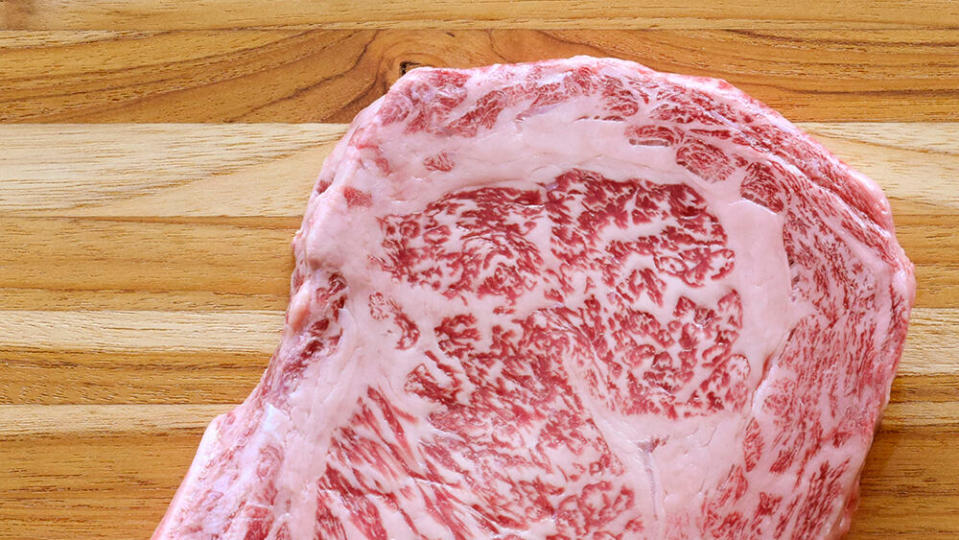
Photo: courtesy D'Artagnan
Cattle have been in Japan for millennia, but the Wagyu we’ve come to know started taking shape in during the Meiji Restoration beginning in 1868, when the government introduced Western influences to the nation. Part of that influence involved beef. Cattle from England, Continental Europe and Korea were imported to Japan and bred with the native stock. Eventually three major strains of black Wagyu emerged: Tajima, Fujiyoshi and Kedaka. These make up 90 percent of Japan’s herd, while the remainder are red strains of Kochi and Kumamoto. Eventually, Japan realized how prized of a breed of cattle it had created and eventually banned the export of any members of the herd, thus ensuring the very best stayed home.
History of Wagyu in the US
In 1976, Morris Whitney brought over four Wagyu bulls from Japan (named Mazda, Mt. Fuji, Rueshaw and Judo) and the American Wagyu was born. Well, more accurately it was born after the bulls were crossbred with American Angus cattle.
Eventually, four Black Wagyu females were brought to the states in 1993 to allow the breeding of full-blooded Wagyu Stateside. A few hundred more followed them in the years after until in 1997, the Japanese government decreed that the Wagyu breed of cattle was a national treasure and banned the export of the breed. So American ranchers had to breed and raise with the genetic lines already introduced to America. That has led to a total herd of Wagyu in the US that’s around 40,000 total with about 5,000 of them being full-blood Wagyu.
Australian Wagyu beef’s rise
Outside of Japan, the largest population of Wagyu cattle isn’t in America, it’s in Australia. However, like American Wagyu, what comes from Australia is crossbred beef. Down Under, you’re not getting that ultra-fatty A5 experience that pure Japanese beef will give you. It’s still likely to have better marbling than cattle that isn’t crossbred with Wagyu though. Also in America, the Wagyu is crossbred with angus, whereas in Australia, they generally use Holsteins, which produce a more tender meat that has less of a beefy flavor than its Stateside counterparts.
And in New Zealand, one ranch raises crossbred Wagyu cattle in a way that’s quite different from the Japanese. First Light’s cattle are grass-fed, not grain finished. Normally grass-fed beef is much leaner; however, the intense marbling of this Wagyu still provides enough fat that you get the best of both worlds with beefy grass-fed flavor and a grain-finished level of marbling.
How are Wagyu cows raised and why do their conditions matter?
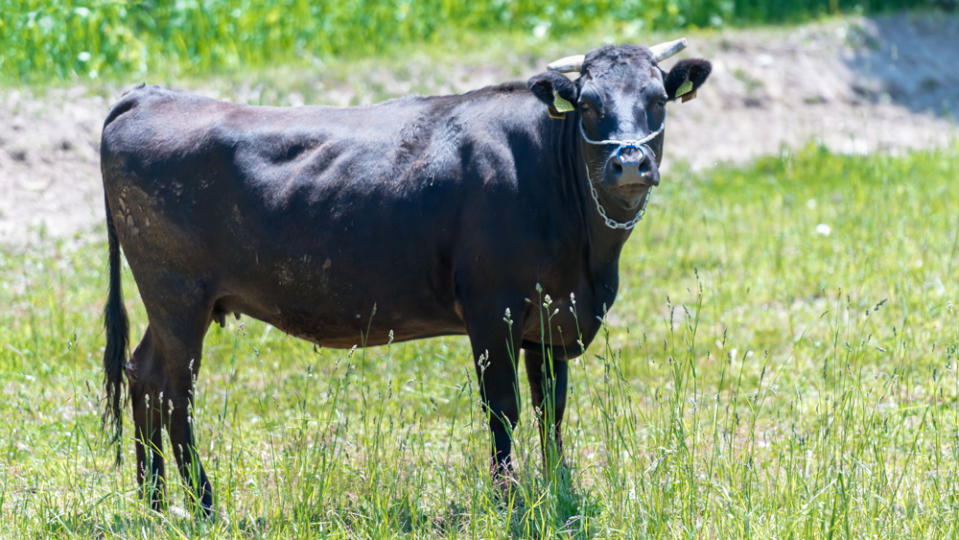
Photo: courtesy Shutterstock
There’s a misconception that Wagyu is produced in the same way that foie gras is: The cows’ movement is limited and they’re force-fed in order to create fatty, tender meat. This couldn’t be further from the truth, according to Heitzeberg. “The number one principle is managing the stress of the animal to zero. Farmers want to make sure these animals from birth to harvest are in a stress-free environment,” Heitzeberg says. “Stress creates cortisol which will deteriorate the quality of beef.”
Japanese cattle-breeders go to great lengths to give their cows a zen-like existence. They control the noise level so animals don’t scare. Farmers constantly replenish water, so there’s a steady supply of fresh, clean H2O to drink. Cows who don’t get along are separated (because what’s more stressful than grazing next to your nemesis?). And unlike some American farms where cows are left to roam free in open pastures, Wagyu cattle are kept on open-air farms where they can be carefully monitored.
“[Crowd Cow] works with farms that will check animals every four hours. In America, if you’re in Montana with a thousand-plus acres, you may not see your animals for seven days,” he says. “They’re out there foraging on the natural Montana grasses, but you don’t know what else they’re doing.” In other words, a cow left to roam, could also be prone to stressful, cortisol-raising experiences.
Wagyu vs. Kobe Beef
You may have heard “kobe” used interchangeably with “Wagyu,” or used to tout an expensive cut of meat. So what is kobe beef? Kobe is essentially just a brand of Wagyu beef, in the same way that Nike is a brand of shoe.
In order for something to be labeled as Kobe beef, first of all, it has to originate in Kobe, Japan. Then, all parties who have a hand in getting this sought-after meat to your table—from the farm to the slaughterhouse to the buyer to the restaurant—has to be licensed by the Kobe Beef Association. “Everyone is paying to be part of the thing called kobe beef,” Heitzeberg says. “But the final thing is they have to be rated A4 or A5—so everything else could be true, but if it’s an A3, you can’t call it Kobe,” Heitzeberg says.
And if you see the words “American kobe” on a menu, take it as a big red flag—American kobe doesn’t exist. “Kobe is from Kobe, Japan, just like Champagne is from Champagne,” Henderson says. “To be true kobe beef, it has to be from Kobe. [Restaurants] cold be part of an association where they’re able to sell kobe beef, but kobe beef is not able to be produced here.”
What does the Wagyu rating system mean?
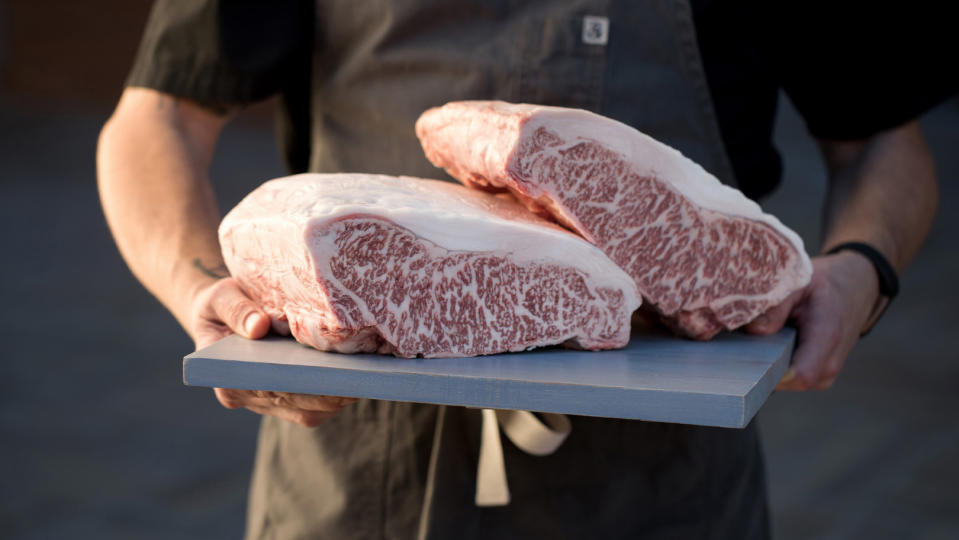
Photo: courtesy Paige Green Photo
When you see Wagyu on a menu, chances are it’ll be alongside an A4 or A5 rating, with A5 representing the most premium level of Wagyu. There are two components that go into that rating.
The first factor—the one that differentiates A’s from your B’s— is yield. “If you were a farmer and had a cow … I would give you a yield score, which tells me how much meat I’ll be able to get off the bones,” Heitzeberg explains. An “A” represents the highest meat yield, while a scrawnier cow will get a “B” rating. This part of the rating is really more for the purveyor than for those of us sidling up to a steak dinner. “What’s important isn’t that A or B, it’s that five or four,” Heitzeberg says.
To understand that four or five, you need to know about another rating system: the Beef Marbling Standard (BMS) rating. The BMS is a scale of one to 12 and relates to both the amount and quality of the marbling. A rating of 12 means you’re getting the highest degree of marbling.
To be rated A5, the meat must have a BMS of 8 to 12. A4 is just below that level, representing a BMS score of 6 through 8. “In the US system, we have the four grades, ranging from Select Choice to Prime,” Heitzeberg says. “A4 and A5 are picking up where Prime leaves off and goes beyond.”
“If you have A5 12 Wagyu, you have the best of the best. It’s not going to get better than that, ever,” says Hilary Henderson, chef de cuisine at CUT by Wolfgang Puck in Beverly Hills, one of America’s best steakhouses. However, this top-tier Wagyu is hard to come by on this side of the Pacific, she says. “Most A5 12 will be sold nose-to-tail in Japanese markets. Unfortunately, we can’t get that here in the states because it won’t pass USDA regulations on the bone.”
Another thing to take into consideration is that in Japan, the rating is an intensely studied skill. To become a rater requires three years of training, and each animal is rated by three separate raters. “It’s important to understand that this rating system is a very Japanese thing. It’s highly skilled, highly regulated and highly practiced,” Heitzeberg explains. In America, there aren’t such stringent rules in place, so the rating may be employed as a gimmick.
“A lot of people in America will say we’re A4 or A5, or we have a BMS score of 7, and I look at that and say, there isn’t a single person who has trained for three years…. You just made that up,” Heitzeberg says.
Best of Robb Report
Why a Heritage Turkey Is the Best Thanksgiving Bird—and How to Get One
The 10 Best Wines to Pair With Steak, From Cabernet to Malbec
Sign up for Robb Report's Newsletter. For the latest news, follow us on Facebook, Twitter, and Instagram.

